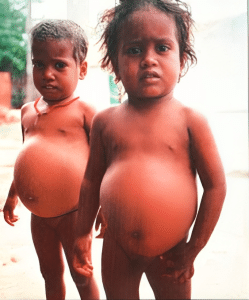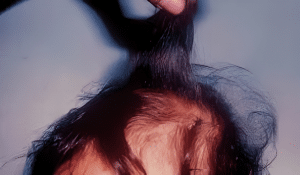What is the Flag Hair Sign in Kwashiorkor and What Does It Mean?

Kwashiorkor is a form of severe acute malnutrition that affects children who do not get enough protein in their diet. It can cause various symptoms, such as swelling of the abdomen and legs, skin rash, hair loss, and growth failure. One of the most distinctive signs of kwashiorkor is the flag hair sign, which refers to the appearance of the hair in affected children. Here, we will explain what the flag hair sign is, what causes it, and how it can be treated.
What Is the Flag Hair Sign?

The flag hair sign is a term used to describe the bands of discoloration of the hair that occurs in children with kwashiorkor. The hair becomes thin, dry, brittle, easily pluckable, sparse, and devoid of its normal sheen. It also becomes straight and hypopigmented, meaning that it loses its natural color. The color of the hair that grows during the period of nutritional deprivation appears reddish brown, blond, or gray, depending on the original color of the hair. These bands of different colors alternate along the length of the hair shaft, creating a flag-like pattern.
The flag hair sign is a characteristic phenomenon of kwashiorkor, but it can also be seen in other conditions that cause protein deficiency or depletion, such as ulcerative colitis, celiac disease, or anorexia nervosa.
What Causes the Flag Hair Sign?
The flag hair sign is caused by a lack of protein and other essential nutrients in the diet. Protein is an important component of hair, as it provides strength and structure to the hair shaft. Protein also contains amino acids that are involved in the synthesis of melanin, the pigment that gives color to the hair.
When there is not enough protein in the diet, the body prioritizes its use for vital functions such as growth and immunity and reduces its use for non-essential functions such as hair production. This results in reduced hair growth and quality, as well as reduced melanin synthesis. The hair becomes weak and fragile and loses its color.
The flag hair sign reflects the fluctuations in protein intake over time. The bands of discoloration correspond to periods of protein deprivation or recovery. The reddish brown color is due to the accumulation of iron in the hair follicles during protein deprivation. The blond or gray color is due to the lack of melanin synthesis during protein deprivation. The darker color is due to the normal melanin synthesis during periods of protein recovery.
How Is the Flag Hair Sign Treated?
The flag hair sign is a sign of severe malnutrition and requires urgent medical attention. The treatment of kwashiorkor involves providing adequate protein and energy intake, as well as micronutrients such as vitamins and minerals. This can be done through oral or intravenous feeding with specially formulated therapeutic foods or milk products. The treatment also involves treating any infections or complications that may be present, such as dehydration, electrolyte imbalance, anemia, or skin infections.
The treatment of kwashiorkor can reverse some of the symptoms and improve the prognosis of the condition. However, some of the effects may be irreversible or long-lasting, such as stunted growth, cognitive impairment, or organ damage. Therefore, prevention is better than cure. The prevention of kwashiorkor involves ensuring adequate food security, nutrition education, breastfeeding promotion, immunization, and infection control.
Conclusion
The flag hair sign is a distinctive sign of kwashiorkor that occurs due to protein deficiency in the diet. It causes bands of discoloration of the hair along its length. The flag hair sign indicates severe malnutrition and requires immediate treatment with protein and energy supplementation. The flag hair sign can also be prevented by ensuring adequate nutrition and health care for children.
References
(1) Flag sign – Altmeyers Encyclopedia – Department Dermatology
(2) Kwashiorkor | DermNet.
(3) Kwashiorkor – www.medicoapps.org.
(4) Why is there a flag symbol in Kwashiorkor? – chroniclesdengen.com.
(5) Flag sign | definition of flag sign by Medical dictionary.
FAQs
Q1: What is a flag hair sign in kwashiorkor?
A1: The flag hair sign is a clinical indicator commonly associated with kwashiorkor, a severe form of malnutrition. It refers to the alternating bands of discoloration in the hair, typically appearing reddish-brown and light-yellow. The hair becomes sparse, brittle, and easily pluckable.
Q2: What causes the flag hair sign in Kwashiorkor?
A2: The flag hair sign is thought to result from disruptions in protein synthesis and malnutrition-related changes in the hair shaft’s pigmentation. Kwashiorkor is characterized by a deficiency of essential amino acids, which are the building blocks of proteins. This deficiency can lead to changes in hair growth and pigmentation.
Q3: Is the flag hair sign specific to Kwashiorkor?
A3: While the flag hair sign is strongly associated with kwashiorkor, it’s not exclusive to this condition. It can also appear in other severe cases of malnutrition or protein deficiency. However, its presence should raise suspicion of underlying nutritional deficiencies.
Q4: Are there other symptoms associated with kwashiorkor?
A4: Yes, kwashiorkor is characterized by a range of symptoms beyond the flag hair sign. These may include edema (fluid retention and swelling), skin changes, weight loss, muscle wasting, fatigue, irritability, and an increased susceptibility to infections.
Q5: Can the flag hair sign be reversed with proper nutrition?
A5: Yes, with appropriate and timely nutritional intervention, including adequate protein intake, the flag hair sign and other symptoms of kwashiorkor can be reversed. However, the recovery process may take time and require comprehensive medical care.
Q6: How is Kwashiorkor diagnosed?
A6: Kwashiorkor is diagnosed through a combination of clinical assessment, medical history, physical examination, and laboratory tests. The presence of symptoms such as flag hair, edema, and other signs of malnutrition, along with blood tests indicating protein and nutrient deficiencies, can help confirm the diagnosis.
Q7: What are the long-term effects of untreated kwashiorkor?
A7: Untreated kwashiorkor can lead to severe health complications and even death. Chronic malnutrition can affect growth and development, weaken the immune system, impair cognitive function, and increase the risk of infections. Timely intervention is crucial to prevent long-term consequences.
Q8: How is kwashiorkor treated?
A8: Treatment of kwashiorkor involves addressing nutritional deficiencies through a gradual increase in protein intake, along with providing essential vitamins and minerals. Medical supervision is necessary to monitor the patient’s progress and manage any complications.
Q9: Can kwashiorkor be prevented?
A9: Yes, kwashiorkor can be prevented through adequate nutrition, particularly by ensuring a balanced diet that includes sufficient protein, carbohydrates, fats, vitamins, and minerals. Education about proper nutrition, especially in communities at risk, plays a crucial role in prevention.
Q10: Who is most at risk for developing kwashiorkor?
A10: Kwashiorkor most commonly affects young children, especially those living in impoverished or food-insecure regions where access to a diverse and nutritious diet is limited. Children who are weaned abruptly from breastfeeding and are not provided with proper complementary foods are at higher risk.
